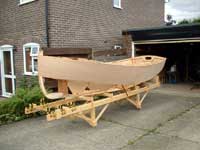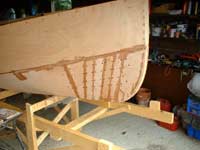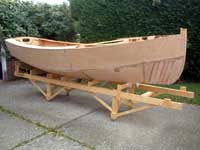|
Burton's Brilliant Bodge |

|
In his account of building his Houdini
"Jackrabbit", Burton Blaise describes how he despaired of bending the
plywood in about fifteen different dimension to make the lower planks
at the bow, and did it with diagonal planking instead.
I've just adopted his method for my own Houdini which will be named
"Rafael", and the idea is so brilliant that it deserves to be repeated
and better publicised - hence this message. No doubt it would work
for
other designs as well.
 |
He despaired of bending the
plywood in about fifteen different dimension to make the lower planks
at the bow
(click images for larger views) |
|
I, too, quickly gave up trying to do the job in one piece. At the
point where the lower plank is no longer wire-stitched to the bottom
plank but is backed by the solid wood of the mast-box, I cut it off
diagonally sloping toward the bow.
diagonal strips just epoxied in place. The rows
of black screws are holding in place the inside straps which ensure
all the planks lie flush and fair. The screws are removed once the
epoxy starts to go off.
|

|
|
I then cut and fettled to fit (a straight edge becomes curved when
it's screwed into position - amazing!) several diagonal planks about
4
or 5 inches wide. I imagine you'd get a fairer curve with narrower
planks, but I'm lazy. Each is screwed in place. I then put two
longitudinal strapping pieces of 6mm ply behind them, and screwed
these from the outside until the epoxy sets. These two straps pull
the
diagonal planks flush with each other, creating quite a decent fair
curve to the outside of the hull.
 |
Inside the foc'sle showing the straps and the temporary
screws. Quite a lot of tidying up to be done!
|
|
Fibreglass mat and plenty of filler inside and out and the job's
done.
It's about 5 million times easier than the conventional method.
Thanks, Burton - you were a real life-saver!
Incidentally, our local hardware store (B&Q - I'm in the UK) has
things called drywall screws. I'd never seen them before. They are
black, self-tapping, bugle-headed and both the point and the thread
are so sharp you don't even have to drill a pilot hole - they
practically pull themselves through the wood! Ideal for holding
things
together temporarily.
On the port side I used planks about five
inches wide which are going to need quite a bit of filling and
fairing. On the starboard side the planks are more and narrower
(about
3 inches), which has worked better I think.
|

|
|

|